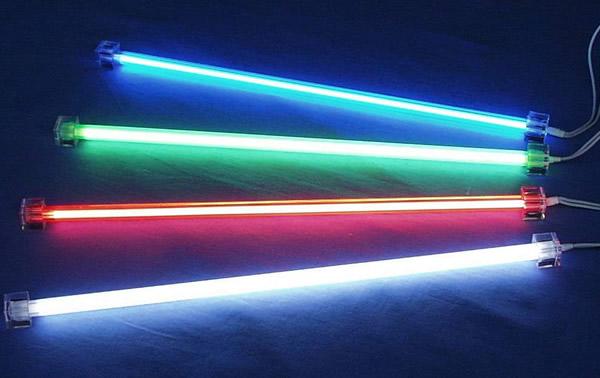1. How to Measure Light Intensity
Install the light intensity standard lamp, LED and silicon photodiode with V(λ) filter on the optical bench and calibrate the parameters. In particular, strictly adjust the position of the filament, the position of the LED light-emitting part and the receiving surface.
First calibrate the silicon photodiode with a light intensity standard lamp, C=E/S
where Es=IS/(d2s)
ds is the distance between the standard lamp and the receiver, Is is the light intensity of the standard lamp, and Rs is the response of the standard lamp.
Es=C/Rt. In the formula, E s is the illuminance of the LED under test, and R t is the response of the LED under test, then the light intensity I t of the LED is: I t=E t /d2t
where d t is the distance between the LED and the receiving surface.
For LEDs, the light-emitting surface is in the shape of a dome, and the light distribution is very special. Therefore, under different measurement distances, the light intensity value will change. Deviating from the inverse square law of distance, even if the measurement distance is fixed, the light intensity value will vary due to the difference in the receiving area of the receiver.
Therefore, in order to improve the measurement accuracy, the measurement distance and the size of the receiving area should be relatively fixed as well. For example, the measurement distance is 316mm recommended by GIE, and the receiver area is fixed at 10×10mm. Under the same measurement distance, the light intensity of the LED varies correspondingly with different corners of the LED. Therefore, in order to obtain the best value, it is better to take the maximum reading R t.
2. Measuring Method of Luminous Flux
The luminous flux measurement is carried out on the turntable of the variable-angle photometer. LEDs are installed on the turntable. The turntable rotates ±90 degrees around its vertical axis in its horizontal plane, and the LEDs rotate 360 degrees around its photometric axis in its vertical plane. The control of the angle of rotation in the horizontal and vertical planes is achieved by means of stepper motors. The turntable moves freely on the guide rail, and when measuring the standard light, the turntable should leave the guide rail.
When measuring, the large turntable rotates around the vertical axis on the horizontal plane, the step angle is 0.9°, the positive direction is 90°, and the reverse direction is 90°. The LED itself is also spinning. At each horizontal angle, signal acquisition is performed every 18° on the vertical plane. After turning 360°, a total of 20 data were collected, and the total luminous flux was calculated as follows.
Correction of measuring angle
If the large plate rotates 0°~90°, the small plate can rotate 0°~360°. However, when the large plate rotates 0° to 90°, it is possible that the LED installation is uneven (asymmetrical) and causes errors. Therefore, the best solution is to rotate the large plate -90°~0°~90°, and the small plate still rotates 0°~360°. Take the average value of the illuminance values at angles with equal absolute values in the two ranges of 0° to 90° and -90° to 0° as the value within 0° to 90°.
The second method of measuring the total luminous flux of an LED is the integrating sphere method. The advantage of this method is that it is simple and easy to implement, but the measurement accuracy is not high. The calculation method of the total luminous flux of LED is as follows. First, calculate the luminous flux Φs of the standard lamp (light intensity value I s) entering the integrating sphere at a distance of 1 from the incident window of the integrating sphere (incident window area A):
Φs=I s ? A /I 2
Read out the photocurrent signal that displays on the receiver, then put the LED on the window and read out the corresponding receiver photocurrent signal it. Then the total luminous flux Φ of the LED is:
Φt=It/IsΦs?K
where K is the color correction coefficient.
3. Measurement Method of Spectral Power Distribution of LED:
The spectral power distribution measurement of light-emitting diodes aims to grasp the spectral characteristics and chromaticity of LEDs. In addition, it is to correct the measured photometric value of the LED.
When measuring LED spectral power distribution, the following points should be noted. One is that the spectral radiance of the standard lamp is much stronger than that of the LED. In order to avoid this problem when comparing with the standard spectral irradiance, it is better to add a neutral filter in front of the standard lamp. Its spectral radiance is close to that of LEDs.
Another problem is that the spectral width of LEDs is very narrow. In order to accurately describe the spectral distribution profile of LEDs, it is best to use a monochromator with a narrow wavelength width for measurement. The wavelength interval is preferably 1 nm.
The spectral power distribution E t of the LED is calculated as follows.
Etλ=Esλ?Itλ/Isλ
where t is the response of the standard lamp at wavelength i, E is the spectral power distribution of the standard lamp, and s is the response of the LED at wavelength λ.
The formula for calculating the color coordinates of LEDs is:
x=∫Etλ?xλdλ
y=∫Etλ?ydλ
z=∫Etλ?ydλ
The color coordinates are:
x=X/(X+Y+Z)
y=Y/(X+Y+Z)
The dominant wavelength and color purity of the LED can also be calculated.
Light emitting diodes are also made of PN structure like ordinary diodes, and also have unidirectional conductivity. It is widely used in various electronic circuits, home appliances, instruments and other equipment as power supply indication or level indication.
* cd (candela) unit of luminous intensity








